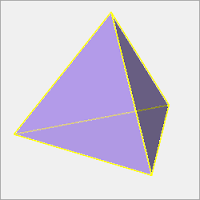Random "Tetrahedron" Walk

Call the vertices of a tetrahedron, A, B, C, and D.
A bug starts on vertex A. Every second he randomly walks along one edge to another vertex. What is the expected value of the number of seconds it will take for him to reach the vertex D?
Clarification:
Every second he chooses randomly among the three edges available to him, including the one he might have just walked along.
Other Expected Value Quizzes
Image credit: http://loki3.com/
This section requires Javascript.
You are seeing this because something didn't load right. We suggest you, (a) try
refreshing the page, (b) enabling javascript if it is disabled on your browser and,
finally, (c)
loading the
non-javascript version of this page
. We're sorry about the hassle.
3 solutions
Since you said 1/3 of the probability of getting D shouldn't it be : E = 1/3 + 2/3 * E ?
Sir can u explain it further .thank you
Log in to reply
Let
E
(
A
)
,
E
(
B
)
,
E
(
C
)
be the expected value of number of seconds it take for him to move to
D
from
A
,
B
,
C
respectively.
Clearly
E
(
A
)
=
3
1
×
1
+
3
1
(
1
+
E
(
B
)
)
+
3
1
(
1
+
E
(
C
)
)
But by symmetry,
E
(
A
)
=
E
(
B
)
=
E
(
C
)
So
E
(
A
)
=
3
1
+
3
1
(
1
+
E
(
A
)
)
+
3
1
(
1
+
E
(
A
)
)
Simplifying yields
E
(
A
)
=
3
The probability that the bug has not reached D after n moves is ( 3 2 ) n , so that the expected value is 1 + 3 2 + ( 3 2 ) 2 + . . . = 1 − 2 / 3 1 = 3
EA = (1/3) 1 + (2/3) (EA+1) EA is the expected move at the beginning, and he has 1/3 chance to move to D, and 2/3 chance to move to B or C; if move to B or C, it just likes the game start from beginning again. EA = 3
Each time he moves he has a 1/3 probability of getting to vertex D, and 2/3 probability of effectively ending up where he started (by symmetry, the vertices can be considered similar).
So, E = 1 + ( 2 / 3 ) E , or E = 3